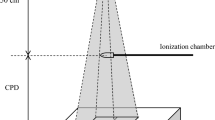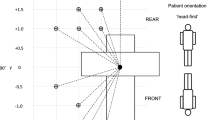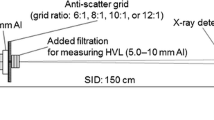Abstract
Objectives
The scatter radiation and scatter rejection effect of air gaps in cephalometric radiography were evaluated using an effective scatter point source (ESPS) model.
Methods
A 16-cm-thick water-equivalent phantom was used to measure the scatter fraction. The distance from the source to the center of the object (SOD) was 150, 200, or 300 cm. The air gap was varied from 0 to 96 cm for each SOD. A photostimulable phosphor plate was used as the X-ray sensor. The measured scatter fraction ESPS model was used to simulate the scatter rejection by the air gap, and the predictions were compared with the grid.
Results
There was excellent agreement between the ESPS model and the scatter measurements. The air gap reduced the scatter radiation, especially for an SOD of 200 or 300 cm, while keeping an object magnification of 1.1 in view of the signal-to-noise ratio improvement factor.
Conclusions
The results suggest that a grid should not be used in cephalometric radiography.
Similar content being viewed by others
References
C Price (1986) ArticleTitleScattered radiation grids in cephalometric radiography Am J Orthod Dentofacial Orthop 90 431–6 Occurrence Handle3465236 Occurrence Handle10.1016/0889-5406(86)90008-9
BW Benson NL Frederiksen PW Goaz (1994) ArticleTitleGrid versus air gap. A comparison of cephalometric techniques Oral Surg Oral Med Oral Pathol 77 86–9 Occurrence Handle8108105 Occurrence Handle10.1016/S0030-4220(06)80113-1
EP Muntz G Jacobson EM Kaegi DJ Klein (1976) ArticleTitleElectronic grids for electrostatic imaging systems Radiology 121 197–204 Occurrence Handle959539
EP Muntz (1979) ArticleTitleAnalysis of the significance of scattered radiation in reduced dose mammography, including magnification effects, scatter suppression, and focal spot and detector blurring Med Phys 6 110–7 Occurrence Handle460060 Occurrence Handle10.1118/1.594540
JA Sorenson J Floch (1985) ArticleTitleScatter rejection by air gaps: an empirical model Med Phys 12 308–16 Occurrence Handle4010635 Occurrence Handle10.1118/1.595690
H Aichinger J Dierker S Joite-Barfus M Sabel (2003) Radiation exposure and image quality in x-ray diagnostic radiology physical principles and clinical applications II.5 Scattered radiation H Aichinger J Dierker S Joite-Barfus M Sabel (Eds) Radiation exposure and image quality in X-ray diagnostic radiology. Physical principles and clinical applications Springer–Verlag Berlin 45–56
InstitutionalAuthorNameInternational Electrotechnical Commission (2001) Publication 60627 IEC Geneva
NA Mandall KD O’Brien HV Worthington (1999) ArticleTitleRadiation reduction using a modified collimated lateral skull radiograph during orthodontic treatment Clin Orthod Res 2 179–85 Occurrence Handle10806941
InstitutionalAuthorNameAnonymous (1985) ArticleTitleThe reduction of the dose to patients during lateral cephalometric radiography. Report of a Joint Working Party of the British Society for the Study of Orthodontics and the British Society of Dental and Maxillofacial Radiology Br J Orthod 12 176–8
SC White MJ Pharoah (2000) Extraoral radiographic examinations SC White MJ Pharoah (Eds) Oral radiology principles and interpretation EditionNumber4th ed Mosby St. Louis 194–204
H Fujita K Ueda J Morishita T Fujikawa A Ohtsuka T Sai (1989) ArticleTitleBasic imaging properties of a computed radiographic system with photostimulable phosphors Med Phys 16 52–9 Occurrence Handle2921980 Occurrence Handle10.1118/1.596402
R Miettunen O Korhola S Savikurki (1991) ArticleTitleThe scatter-to-primary ratio as a function of varying X-ray absorption measured by computed radiography Eur J Radiol 13 156–9 Occurrence Handle1743195 Occurrence Handle10.1016/0720-048X(91)90099-H
CE Floyd JY Lo HG Chotas CE Ravin (1991) ArticleTitleQuantitative scatter measurement in digital radiography using a photostimulable phosphor imaging system Med Phys 18 408–13 Occurrence Handle1870483 Occurrence Handle10.1118/1.596687
TS Curry SuffixIII JE Dowdey RC Murry SuffixJr (1984) Grids TS Curry SuffixIII JE Dowdey RC Murry SuffixJr (Eds) Christensen's introduction to the physics of diagnostic radiology EditionNumber3rd ed Lea & Febiger Philadelphia 88–106
U Neitzel (1992) ArticleTitleGrids or air gaps for scatter reduction in digital radiography: a model calculation Med Phys 19 475–81 Occurrence Handle1584148 Occurrence Handle10.1118/1.596836
HP Chan K Doi (1982) ArticleTitleInvestigation of the performance of antiscatter grids: Monte Carlo simulation studies Phys Med Biol 27 785–803 Occurrence Handle7111390 Occurrence Handle10.1088/0031-9155/27/6/002
JW Motz M Danos (1978) ArticleTitleImage information content and patient exposure Med Phys 5 8–22 Occurrence Handle634242 Occurrence Handle10.1118/1.594405
JM Boone KK LIndfors VN Cooper JA Seibert (2000) ArticleTitleScatter/primary in mammography: comprehensive results Med Phys 27 2408–16 Occurrence Handle11099211 Occurrence Handle10.1118/1.1312812
RH Miettunen OA Korhola (1991) ArticleTitleThe effect of scatter reduction on the signal-to-noise ratio in computed radiography Eur J Radiol 12 167–70 Occurrence Handle1855509 Occurrence Handle10.1016/0720-048X(91)90066-5
Author information
Authors and Affiliations
Corresponding author
Rights and permissions
About this article
Cite this article
Tsuji, Y., Araki, K., Endo, A. et al. Scatter radiation and the effects of air gaps in cephalometric radiography. Oral Radiol 22, 7–13 (2006). https://doi.org/10.1007/s11282-006-0038-7
Received:
Accepted:
Issue Date:
DOI: https://doi.org/10.1007/s11282-006-0038-7




